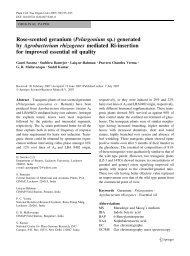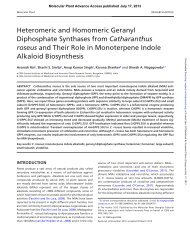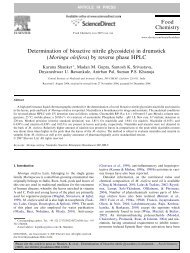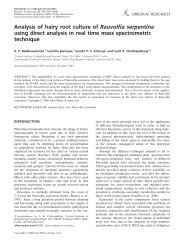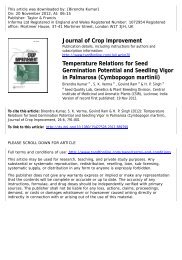Volume 2. Issue 1. ISSN 1555-9475 (online) www ... - CIMAP Staff
Volume 2. Issue 1. ISSN 1555-9475 (online) www ... - CIMAP Staff
Volume 2. Issue 1. ISSN 1555-9475 (online) www ... - CIMAP Staff
- No tags were found...
Create successful ePaper yourself
Turn your PDF publications into a flip-book with our unique Google optimized e-Paper software.
AFLP based detection of adulterants in Safed Musli complex Natural Product Communications Vol. 2 (1) 2007 97reactions. For selective amplification the reactionswere set up as follows: 3 μL of 20-fold dilutedpreselective amplification product, 15 μL AFLP coremix, 1 μL MseI primer 5’-[Primer-Cxx]-3’, <strong>1.</strong>5 μLEcoRI primers 5’-[Dye-Primer-Axx]-3’{0.5 μL of 3EcoRI primers each were pooled here}. Selectiveamplification was carried out in a thermal cyclerprogrammed as: 94°C for 2 min; 10 cycles of 94°Cfor 20 sec, 66°C (-1°C/cycle) for 30 sec, 72°C for 2min; 20 cycles of 94°C for 20 sec, 56°C for 30 sec,72°C for 2 min; 60°C for 30 min; and 4°C forinfinity. The samples were loaded onto a 5%polyacrylamide gel on an ABI Prism 377 DNASequencer. For gel electrophoresis, 3 μL of theselective amplification reaction product was mixedwith 4 μL of loading buffer {ROX500 size standard(10%), blue dextran (10%), deionised formamide(80%)}, and <strong>1.</strong>5 μL of this mix was finally loaded onthe gel. For AFLP reactions the AFLP amplificationmodules and the guidelines supplied by AppliedBiosystems, USA were used.Data analysis: For diversity analysis bands werescored as present (1) or absent (0) to form a raw datamatrix. A square symmetric matrix of similarity wasthen obtained using Jaccard similarity coefficient [6]by SPSS v7.5 software .The average similarity matrixwas used to generate a tree for cluster analyses byUPGMA (Unweighted Pair Group Method withArithmetic average) method using NTSys v<strong>2.</strong><strong>1.</strong>Acknowledgments - The authors gratefullyacknowledge the financial help provided by ICMRand CSIR, India.References[1] Oudhia P. (2000) Problems perceived by safed musli (Chlorophytum borivilianum) growers of Chhattisgarh (India) region: Astudy. Journal of Medicinal and Aromatic Plant Sciences, 23, 396-399.[2] Shariff A, Chennaveeraiah MS. (1972) Karyomorphology of four diploid species of Chlorophytum. Nucleus, 15, 39-45.[3] Bordia PC, Joshi A, Simlot MM. (1995) Safed moosli. In KL Chadha and Rajendra Gupta (eds.), Advances in Horticulture, Vol. II.Medicinal and aromatic plants. Malhotra Publ. House, New Delhi, India, 429-45<strong>1.</strong>[4] Khanuja SPS, Shasany AK, Darokar MP, Kumar S. (1999) Rapid isolation of PCR amplifiable DNA from the dry and fresh sampleof plants producing large amounts of secondary metabolites and essential oils by modified CTAB procedure. Plant MolecularBiology Reporter, 17, 74.[5] Vos P, Hogers R, Bleeker M, Reijans M, van de Lee T, Hornes M, Frijters A, Pot J, Paleman J, Kuiper M, Zabeau M. (1995) AFLPa new technique for DNA fingerprinting. Nucleic Acids Research, 23, 4407-4414[6] Jaccard P. (1908) Nouvelles recherches sur la distribution florale. Bulletin de la Societe Vaudoise des Sciences Naturelles, 44,223-270.[7] Virk PS, Ford-Lloyed BV, Jackson MT, Newburry HJ. (1995) Use of RAPD for the study of diversity within plant germplasmcollections. Heredity, 74, 174-179.[8] Jain N, Shasany AK, Sundaresan V, Rajkumar S, Darokar MP, Bagchi GD, Gupta AK, Kumar S, Khanuja SPS. (2003) Moleculardiversity in Phyllanthus amarus assessed through RAPD analysis. Current Science, 85, 1454-1458.[9] Hansen M, Kraft T, Christiansson M, Nilsson NO. (1999) Evaluation of AFLP in Beta. Theoretical and Applied Genetics, 98,845–85<strong>2.</strong>[10] Jones CJ, Edwards KJ, Castaglione S, Winfield MO, Sala F. (1997) Reproducibility testing of RAPD, AFLP and SSR markers inplants by a network of European laboratories. Molecular Breeding, 3, 381–390.[11] Vuylsteke M, Mank R, Brugmans B, Stam P, Kuiper M. (2000) Further characterization of AFLP data as a tool in genetic diversityassessments among maize (Zea mays L.) inbred lines. Molecular Breeding, 6, 265–276.[12] Hill M, Witsenboer H, Zabeau M, Vos P, Kesseli R, Michelmore RW. (1996) AFLP fingerprinting as a tool for studying geneticrelationships in Lactuca spp. Theoretical and Applied Genetics, 93, 1202–1210.[13] Koopman WJM, Zevenbergen MJ, Van den Berg RG. (2001) Species relationships in Lactuca S.L. (Lactuceae, Asteraceae)inferred from AFLP fingerprints. American Journal of Botany, 88, 1881-1887.[14] Alonso-Blanco C, Peeters AJM, Koornneef M, Lister C, Dean C, van den Bosch N, Pot J, Kuiper MTR. (1998) Development of anAFLP based linkage map of Ler, Col and Cvi Arabidopsis thaliana ecotypes and construction of a Ler/Cvi recombinant inbred linepopulation. Plant Journal, 14, 259–27<strong>1.</strong>[15] Polanco C, Ruiz ML. (2002) AFLP analysis of somaclonal variation in Arabidopsis thaliana regenerated plants. Plant Science, 162,817–824.





